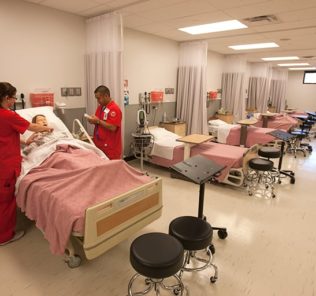Virtu-Wil Free Canadian Student Virtual Healthcare Simulation Program
In 2021, a free and open access Canadian virtual healthcare simulation program was created called Virtu-WIL. Colleges and Institutes throughout Canada collaborated with Simulation Canada which is an interprofessional but non for profit network dedicated to advancement of healthcare simulation. Simulation Canada led the development of the Virtu-WIL virtual healthcare simulation program. The program was government funded with contributors to the project from 24 colleges and institutions and 13 universities across Canada. This article by Erin Carn-Bennett, MSN, RN will explore the Virtu-WIL virtual clinical simulation program.
Educators across Canada and beyond have access to over 185 virtual healthcare simulations in the Virtu-Wil virtual clinical simulation program. The Virtu-Wil virtual clinical simulation program has been designed for students of nursing, medical laboratory sciences, sonography, and paramedicine. The Virtu-Wil virtual simulation program is an innovative and hands-on educational experience which assists students to acquire practical competencies.
The virtual clinical simulations are openly licensed by creative commons for Canadian educators and students. Many virtual simulations are accessible to educators across the world by an enrolment at the website. In Canada, similar to most if not all countries across the world, there is a shortage of healthcare providers. Due to this staff shortage, there is now also a large lack of high quality clinical placements for healthcare students.
Sponsored Content:
Virtu-WIL Program is Created by Canadian Educators from Clinical Experiences
The virtual clinical simulations in the Virtu-WIL program are based on and created from simulated clinical experiences. The process of creation of these virtual clinical simulations from a clinical backstory is done by Canadian educators. All of the virtual clinical simulations are based on clearly defined pedagogical objectives, which great time has been taken to consider.Most of the virtual clinical simulations can be operated on a desktop computer, but some of the virtual scenarios require a virtual reality (VR) headset.
For each of the virtual clinical simulations, students are given a clinical situation to figure out and also assess. After each virtual clinical simulation the individual or group are then given feedback on their clinical decisions. The Virtu-WIL program is dedicated to the empowerment of educators in the virtual clinical simulation environment and a number of resources are available to educators as part of the program.
Article Published in Advanced in Simulation Journal Reviews Virtu-WIL Program’s Impact
Sponsored Content:
A journal article written by Verkuyl, Violato and Harder et al (2024) named “Virtual simulation in healthcare education: a multi-professional, pan-Canadian evaluation”. This has been published in the journal Advances in Simulation and describes the research and review processes of the Virtu-WIL program. The study was created in order to evaluate the program which was also made freely available to the international community.
In the review of feedback of the virtual clinical simulation program, students were able to self-report experiences from the virtual simulations. As well as this data being captured, the impact that these virtual simulations had on students individual preparedness for clinical practice was captured. A variety of survey questions were asked in order to collate the students’ responses.
View the LEARN CE/CME Platform Webinar Assess Clinical Judgment Virtually with Sentinel U’s Prioritization of Care and Professional Nursing Series to learn more!
The post Virtu-WIL virtual simulation experience survey was of 1715 Nursing, Paramedicine and Medical Laboratory students from 18 post-secondary universities, colleges, and institutions. Results demonstrated that most of the students surveyed found the Virtu-WIL program assisted with learning and preparation for clinical practice.One of the most critical outcomes from the post course survey was that virtual based healthcare simulations as a stand alone program was not enough for learners and pedagogy plans were a highly critical element of lesson plans.
All of the students that had enrolled at the end of 2022 and start of 2023 in the Virtu-WIL program from 18 schools across Canada responded to the survey. The vast majority of respondents were satisfied or very satisfied (1455, 86.2%) with the Virtu-WIL experience. One hundred and twenty-nine (7.6%) were very dissatisfied, 25 (1.5%) were dissatisfied, while 80 (4.7%) were neither satisfied nor dissatisfied.
The research outcomes discussed in the Virtu-WIL article discovered some ways in which the number of required hours for clinical placements could potentially be decreased. Also not only this, but ways in which to enhance the in person clinical practicum experiences that were attended. Identifications were also made around more research being required around how to integrate virtual clinical simulation programs into established curricula and also at what time points in student clinical rotations were optimal for student experiences.
Although key learning objectives are centered around technical skills for clinical practice, other skills are also present to be obtained around communication, time management, and rapport building skills. Problem-solving and critical thinking capabilities around patient assessment and care are also embedded into the virtual simulations.
The ability to be able to receive immediate feedback after the virtual clinical simulation has been shown to be incredibly important to the learning. Other key factors of the program are the requirement to prepare healthcare students for clinical placements. The Virtu-Wil program is able to be accessed by students from a desktop computer, tablet or smartphone. Facilitators of the Virtu-WIL program were encouraged to follow a provided pedagogical process which included both a pre-brief and a debrief.
Three major themes were found in the open-ended comments data. The themes identified were: development of essential skills, simulation-specific skills, and preparation for internship. Students made comments that the virtual simulations assisted to develop essential skills for clinical practice. Essential skills built into the virtual simulations included: clinical judgment, prioritization, delegation, problem-solving, communication, and teamwork. Teamwork included collaboration, conflict management, and how to respond to bullying from patients and other staff.
Examples of clinical care embedded into the virtual clinical simulations included administering a spacer to a patient with asthma, caring for a dementia patient, PCA pump operation, management of anaphylaxis, blood transfusion reaction, feeding a patient with dysphagia, and caring for the post-operative patient. These clinical skills included: assessment, treatment, and documentation for these examples listed.
The Virtu-WIL virtual clinical simulation program has been able to demonstrate and provide students with incredibly effective virtual clinical simulation scenarios that include examples from practice. Depth is added to the process of knowledge acquisition in a virtual clinical simulation environment by debrief discussions with experienced facilitators. The Virtu-WIL program which was created by Simulation Canada with government funds is a great example of the creation of a virtual clinical simulation program that has the ability to meet a number of learning outcomes and better prepare students for clinical placements.
Learn More on the Virtu-WIL website today!
Reference: Verkuyl, M., Violato, E., Harder, N. et al. Virtual simulation in healthcare education: a multi-professional, pan-Canadian evaluation. Adv Simul 9, 3 (2024).
Erin Carn-Bennett is a Simulation Nurse Educator for the Douglas Starship Simulation Programme in Auckland, New Zealand. Carn-Bennett has her Masters of Nursing and has an extensive nursing career within pediatric emergency and also nursing management. She is passionate about debriefing and all things simulation. Carn-Bennett is a member of the IPSS board of directors. Carn-Bennett is the lead host of the podcast Sim Nurse NZ.
Sponsored Content:
















